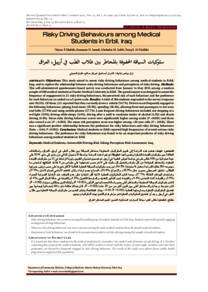وثيقة
Risky driving behaviours among medical students in Erbil, Iraq.
المعرف
DOI: 10.18295/squmj.2015.15.03.014.
المساهمون
عناوين أخرى
سلوكيات السياقة المحفوفة بالمخاطر بين طلاب الطب في أربيل، العراق
الناشر
College of Medicine, Sultan Qaboos University.
ميلادي
2015-08
اللغة
الأنجليزية
الملخص الإنجليزي
Objectives: This study aimed to assess risky driving behaviours among medical students in Erbil, Iraq, and to explore the relationship between risky driving behaviours and perceptions of risky driving. Methods: This self-administered questionnaire-based survey was conducted from January to May 2014 among a random sample of 400 medical students at Hawler Medical University in Erbil. The questionnaire was designed to assess the frequency of engagement in 21 risky driving behaviours, the perceived risk of each behaviour and the preference for each behaviour as ranked on a 5-point scale. Results: A total of 386 students responded to the survey (response rate: 96.5%). Of these, 211 reported that they currently drove a vehicle (54.7%). Drivers most frequently engaged in the following behaviours: playing loud music (35.9%), speeding (30.4%), allowing front seat passengers to not wear seat belts (27.9%) and using mobile phones (27.7%). Least frequent driving behaviours included not stopping at a red light (3.9%), driving while sleepy (4.4%), driving after a mild to moderate intake of alcohol (4.5%) and drunk driving (6.4%). Mean risky driving behaviour scores were significantly higher among males (P <0.001) and those who owned a car (P = 0.002). The mean risk perception score was higher among >20-year-olds (P = 0.028). There was a significant positive relationship between the preference for risky behaviours and risky driving behaviours (beta = 0.44; P <0.001). Conclusion: Medical students in Erbil reported high frequencies of several serious risky driving behaviours. The preference for risky behaviours was found to be an important predictor of risky driving behaviours among medical students in Erbil.
المجموعة
URL المصدر
zcustom_txt_2
Shabila, Nazar P., Ismail, Kamaran H., Saleh, Abubakir M., & Al-Hadithi, Tariq S. (2015). Risky Driving Behaviours among Medical Students in Erbil, Iraq. Sultan Qaboos University Medical Journal, 15 (3), 390–397.
الملخص العربي
الهدف: هدفت هذه الدراسة إلى تقييم السلوكيات المحفوفة بمخاطر السياقة بين طلاب الطب في أربيل، العراق، واستكشاف العلاقة بين سلوكيات القيادة الخطرة وتصوراتها. الطريقة: تم إجراء هذه الدراسة بواسطة الاستبيان الذاتي من يناير إلى مايو 2014 على عينة عشوائية من 400 طالب طب في جامعة هولير الطبية في أربيل، ثم تصميم استبيان لتقييم وتيرة الارتباط في 21 من سلوكيات القيادة الخطرة، والمخاطر المتوقعة من كل سلوك وتفضيل كل سلوك على الآخر حسب تصنيفها على مقياس من 5 نقاط. النتائج: استجاب ما مجموعه 386 طالبا للدراسة (معدل الاستجابة: %196.5 تم رصد سلوكيات السياقية الخطرة التالية الأكثر شيوعا على حسب ترتيب حدوثها للطلاب: تشغيل الموسيقى بصوت عال (%35.9)، والإسراع (%30.4)، السماح بعدم ارتداء ركاب المقعد الأمامي لحزام الأمان (%27.9) واستخدام الهواتف النقالة (%27.7). بينما كانت السلوكيات الخطرة الآتية أقل انتشارا مثل، عدم التوقف عند الإشارة الضوئية الحمراء (39)، والقيادة أثناء النعاس (4.496)، والقيادة تحت التأثير الخفيف والمتوسط للكحول (4.596) والقيادة في حالة السكر البين (%6.4) كانت سلوكيات السياقة المحفوفة بالمخاطر أعلى بصورة دالة إحصائيا بين الذكور (0.001> P) وأولئك الذين يمتلكون سيارة (0.002 = P). كان متوسط درجة إدراك مخاطر أعلى بين الذين أكبر من سن 20 عاما (0.028 = P). كان هناك علاقة ذات دلالة إحصائية إيجابية بين تفضيل السلوكيات الخطرة وممارستها الفعلية (0.001> P ;0.44 - بيتا). الخلاصة: ينتشر العديد من سلوكيات السياقة الخطرة بين طلاب الطب في أربيل. وجد أن تفضيل السلوكيات الخطرة هو مؤشر هـام للتنبؤ بهذه السلوكيات بينهم.
قالب العنصر
مقالات الدوريات

